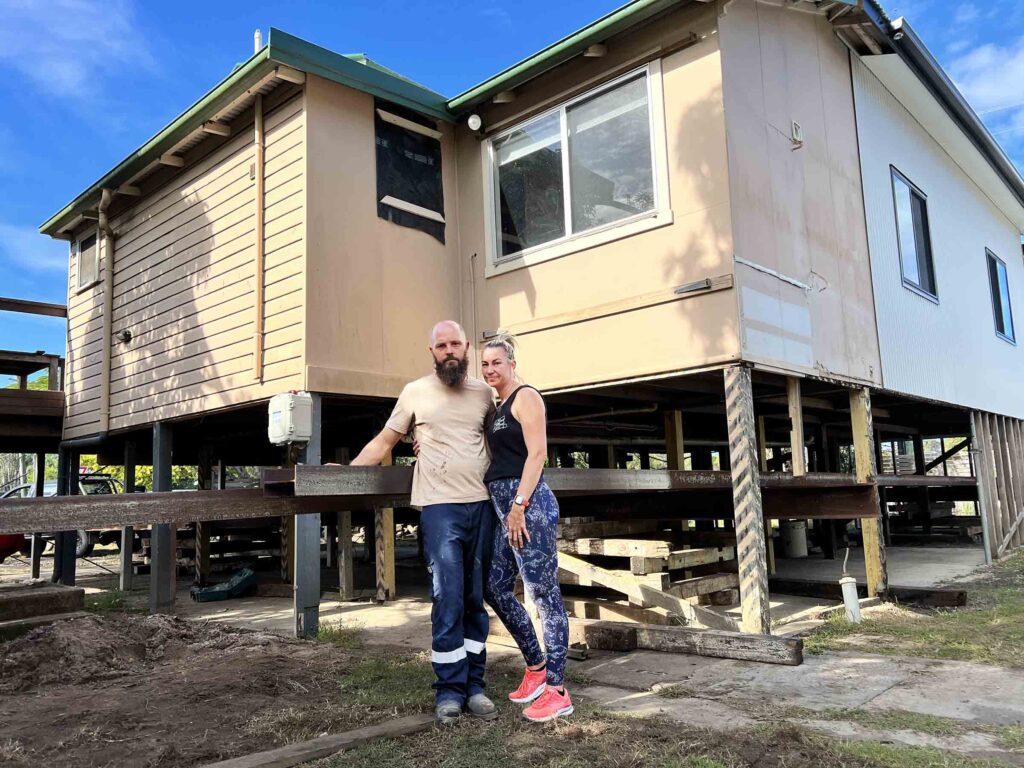ABOVE: Luke O’Driscoll and Cass Petty stand next to their Broadwater home which was raised another 1.5 metres from what is shown in this photo.
Susanna Freymark
Luke O’Driscoll is trying to get his home together for his family since the floods. He raised his Broadwater home and was expecting to get some financial help from the Northern Rivers Reconstruction Corporation. Read Luke’s story here.
The other day, Luke got the call. He was told he wasn’t getting anything.
His response was to write a letter to Richmond Valley Council, local MPs and media outlets.
Here is a slightly edited version of his letter. It shows how flood-impacted residents are really feeling.
“What are you doing for flood-affected residents?
I write to you out of anger, heartache and complete desperation. I have been informed that my home on Baraang Drive in Broadwater is not eligible for the Resilient Homes Program, despite being identified as priority 4 on the NRRC maps, which their website lists as identified for retrofit/raising.
I was lied to by a government spokesperson (David Witherdin) when in an NRRC meeting held at the Broadwater Hall, he assured my community and I when I asked him directly if I spend money now to raise my home and make it flood resilient will I be reimbursed through this scheme? He assured me I would be.
I have been slowly progressing by acting as soon as possible, which has been important mentally during this time. Even with immediate action, my house is just at the beginning of lifting and repairs. If I had waited for the government’s lies to be revealed, I would be 17 months delayed for no reason. Instead, I will have an unfinished, raised, more flood-resilient home, in line with the program aims, yet not eligible for the grant.
I was more fortunate than most in my community to have the funds to begin the process (using) my savings from a six-month deployment to Afghanistan in 2011, serving the Government of Australia. While this money will raise my house, the funds will be depleted before I complete both sets of stairs, a kitchen and many other minor details.
I trusted the government and its spokesperson to fulfil their promise. I was relying on reimbursement through the grant to finish putting my house back together. I will never come out ahead in this situation; my life savings depleted, my house value diminished, and my possessions destroyed by water and mould. But my house would again feel safe for my family to return.
With a raised house, my direct neighbour stayed safe during the flood, with water peaking at his top step. He agreed with police the next day to leave the property due to no power or water. He returned after a week when power was restored. Other suitably raised houses in Broadwater had similar results. Making it obvious why I chose to pursue raising my house.
However, if I knew I would not qualify for the promised grants, I would have repaired it in place. I attempted to confirm eligibility numerous times by emailing council members, MPs and the NRRC, with no response.
So, at the 11th hour (Friday, June 30), I received a phone call from Services NSW, telling me my property was assessed as not eligible. However, they could not provide details or a copy of my property assessment. They informed me I could appeal.
What do I appeal to? An assessment that has not been provided to me. My property is identifiable as priority 4 on the maps for raising/retrofitting, and I do not wish to appeal that.
The risk of the flood to the life of my 35-week pregnant partner and two year old daughter was extremely high. Do I appeal based on this?
There was no risk to emergency services, as they did not come. They were grossly unprepared, untrained and not equipped for the event. Do I appeal based this? Our reliance on a volunteer-based SES, staffed by retirees or poorly trained community members, is a national disgrace, but an argument for another day. I witnessed a NSW swift water rescue crew sit on the Pacific Highway for three days at New Italy because they could not access the region. Do I use this detail in my appeal?
Richmond Valley Council definitely requires assistance to make the house raising process faster and simpler. After trickle-feeding me various fees to pay across multiple weeks for a construction certificate. The latest delay was paying a council contributions fee. The fee was sent as a letter through the planning portal, not an invoice, a letter stating the fee, with no direction on how to pay it. With the fee paid over the phone to the council, I was assured my application for a construction certificate would continue. After a week of no progress, I checked the portal and noticed it awaited my action. The application had not progressed as I had not clicked Respond, as the Respond button is not visible to me on my mobile phone – the primary device I have access to while piecing my life back together.
RVC still needs to create special assistance or circumstances for flood recovery works, monitoring and assisting owners in every aspect. Not a single fee has been waived or discounted. We are still paying rates; we are still paying mortgages. We are still insuring our damaged houses.
All affected LGA councils already failed us by not actively pursuing and offering the old Department of Planning and Environment voluntary house raising scheme (VHRS) every financial year since its inception. RVC informed me, “No houses have utilised this scheme in the Richmond Valley since 2008…”.
If council persisted with that existing scheme, even only two houses a year, would mean dozens more houses in RVC alone, possibly hundreds across the LGAs, would have already been more flood resilient.
Please stop our MPs saying they are not responsible for what a previous government said, it is weak and pathetic, make them accountable!
They are the same government, state or federal, and responsible for upholding the decisions of those before them.
We were promised:
2000 buybacks
2000 house raises
2000 retrofits
I need help. My town needs help. My LGA needs help. The entire region still needs help.”
Despairing residents express anger over fudged flood figures



